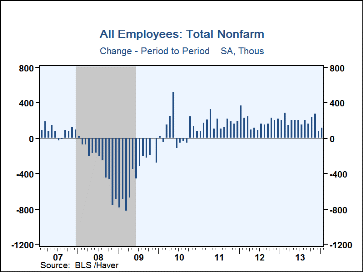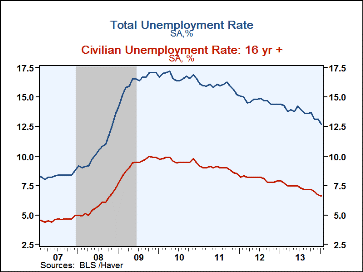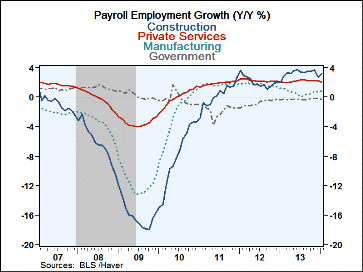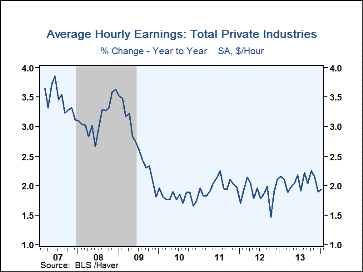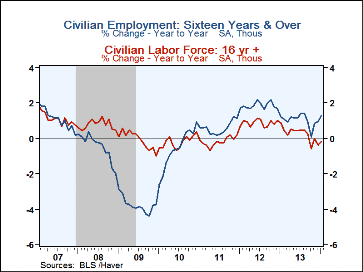 Global| Feb 07 2014
Global| Feb 07 2014U.S. Payroll Employment Growth Disappoints Again Though Jobless Rate Touches New Low
by:Tom Moeller
|in:Economy in Brief
Summary
Nonfarm payrolls grew 113,000 (1.7% y/y) during January following gains of 75,000 and 274,000 during the prior two months, initially reported as 74,000 and 241,000. The rise disappointed expectations for a 185,000 increase. Earlier [...]
Nonfarm payrolls grew 113,000 (1.7% y/y) during January following gains of 75,000 and 274,000 during the prior two months, initially reported as 74,000 and 241,000. The rise disappointed expectations for a 185,000 increase. Earlier figures were revised. The unemployment rate fell to 6.6%, the lowest level since October 2008, versus expectation for 6.7. The total jobless rate, including workers who were marginally attached and part-time for economic reasons, declined to 12.7%, the lowest level since November 2008.
From the establishment survey, the 113,000 monthly increase in jobs was one of the smallest since 2010. On the firm side, factory sector payrolls gained 21,000 (0.8% y/y) and construction jobs rose 48,000 (3.1% y/y), both bouncing back from modest December readings. Offsetting this strength was a weak 66,000 increase (2.1% y/y) in private service sector jobs. Notable was the 12,900 decline (+2.1% y/y) in retail employment, though that followed an outsized 62,700 December gain. Education & health services jobs posted a 6,000 decline (+1.5% y/y), the second consecutive down month. Financial activities employment fell 2,000 (+0.8 y/y). It has been unchanged during the last six months. Also falling were government sector payrolls. The 29,000 worker shortfall (-0.2% y/y) reflected declines in each sector of government. To the upside, leisure & hospitality employment rose 24,000 (3.1% y/y), though its trend growth has been slowing since the middle of last year. Professional & business services employment advanced a modest 36,000 (3.6% y/y) after a negligible 4,000 December rise while transportation & warehousing jobs grew 9,900 (1.8% y/y).
The overall breadth of job growth improved slightly last month to a modest 61.2% of industries. During the last three months, jobs rose in 66.1% of businesses. In the factory sector, a reduced 54.3% of industries added workers last month but a firm 64.8% have done so over the last three months.
The length of the average workweek remained down from its expansion high at 34.4 hours. That reflected a lessened factory sector reading of 40.2 hours, off from the expansion high of 40.6 hours reached in November. The private service producing workweek held at 33.2 hours, down from the March high of 33.4 hours.
Average hourly earnings gained 0.2% (1.9% y/y) after no change in December. Over the last year, factory sector earnings have been the strongest across sectors, posting 2.5% wage growth. Private services followed with a 1.8% gain while construction sector wages grew 1.4%.
From the household sector jobs report, the unemployment rate's decline to 6.6% reflected a 638,000 (1.3% y/y) rise in employment and a 523,00 increase (-0.2 y/y) in the labor force. The rise in the labor force lifted slightly participation slightly as a percent of the population to 63.0%. The labor force participation rate remained, however, at the lowest level since 1978. Potential workers who were not in the labor force grew by 2.8% y/y. The adult employment-to-population rate remained at 61.0%, down from its 2000 high of 65.3%. For adult men, it held at 68.0% and for women it was steady at 54.6%. The average duration of unemployment fell to 35.4 weeks, a twelve month low. The ranks of the long-term unemployed (52 weeks or more) fell roughly one quarter y/y.
Education continued to pay off. The unemployment rate for those with less than a high school diploma remained high at 9.6% last month but employment rose 1.1% y/y. For high school graduates, joblessness was 6.5% with jobs flat y/y. Those with some college saw an unemployment rate of 6.0% with a slight dip in jobs and college graduates were jobless at a 3.2% rate with employment up 3.5% y/y.
The figures referenced above are available in Haver's USECON database. Additional detail can be found in the LABOR and in the EMPL databases. The expectation figures are from Action Economics and are in the AS1REPNA database.
| Employment: (M/M Chg., 000s) | Jan | Dec | Nov | Y/Y | 2013 | 2012 | 2011 |
|---|---|---|---|---|---|---|---|
| Payroll Employment | 113 | 75 | 274 | 1.7% | 1.7% | 1.7% | 1.2% |
| Previous | -- | 74 | 241 | -- | 1.6 | 1.7 | 1.2 |
| Manufacturing | 21 | 8 | 35 | 0.8 | 0.7 | 1.7 | 1.7 |
| Construction | 48 | -22 | 32 | 3.1 | 3.3 | 2.1 | 0.2 |
| Private Service Producing | 66 | 102 | 204 | 2.1 | 2.2 | 2.2 | 1.9 |
| Government | -29 | -14 | 2 | -0.2 | -0.3 | -0.8 | -1.8 |
| Average Weekly Hours - Private Sector | 34.4 | 34.4 | 34.5 | 34.4 (Jan'13) |
34.5 | 34.4 | 34.3 |
| Average Private Sector Hourly Earnings (%) | 0.2 | 0.0 | 0.2 | 1.9 | 2.1 | 1.9 | 2.0 |
| Unemployment Rate (%) | 6.6 | 6.7 | 7.0 | 7.9 (Jan'13) |
7.4 | 8.1 | 8.9 |
Tom Moeller
AuthorMore in Author Profile »Prior to joining Haver Analytics in 2000, Mr. Moeller worked as the Economist at Chancellor Capital Management from 1985 to 1999. There, he developed comprehensive economic forecasts and interpreted economic data for equity and fixed income portfolio managers. Also at Chancellor, Mr. Moeller worked as an equity analyst and was responsible for researching and rating companies in the economically sensitive automobile and housing industries for investment in Chancellor’s equity portfolio. Prior to joining Chancellor, Mr. Moeller was an Economist at Citibank from 1979 to 1984. He also analyzed pricing behavior in the metals industry for the Council on Wage and Price Stability in Washington, D.C. In 1999, Mr. Moeller received the award for most accurate forecast from the Forecasters' Club of New York. From 1990 to 1992 he was President of the New York Association for Business Economists. Mr. Moeller earned an M.B.A. in Finance from Fordham University, where he graduated in 1987. He holds a Bachelor of Arts in Economics from George Washington University.


